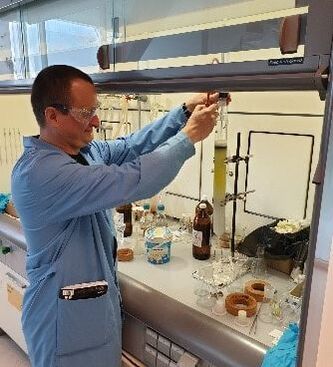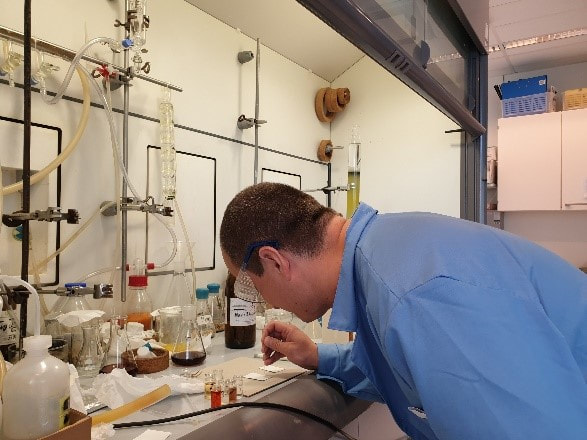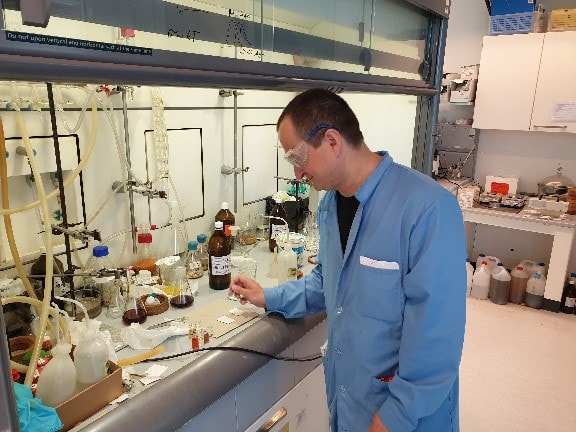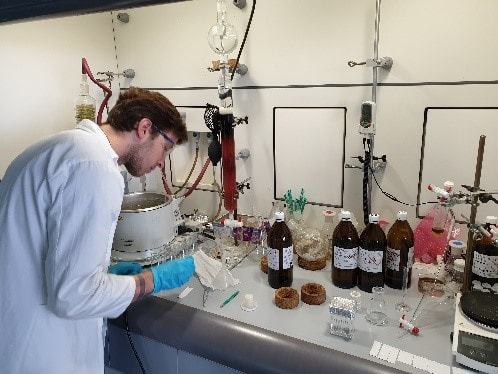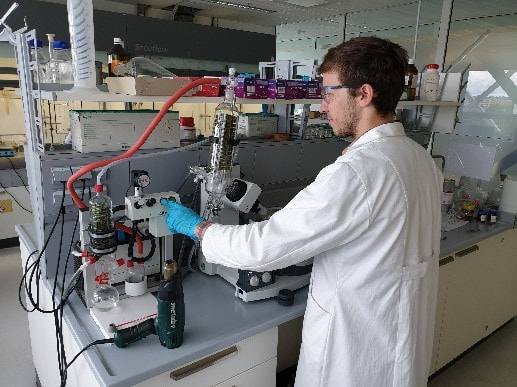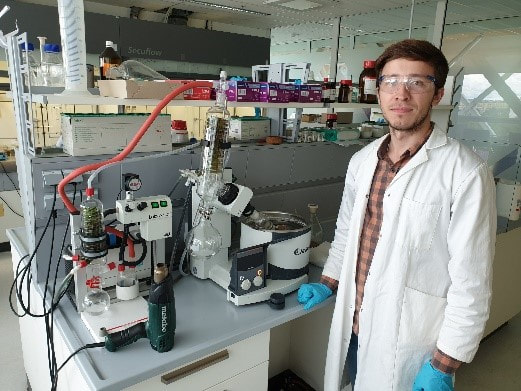09.07.2019
Two researchers from Belarus State University (BSU) - Dmitry Shiman and Aliaksei Vaitusionak - have been recently undertaking two months secondments at Kaunas University of Technology (KTU) in the context of the MEGA project.
Among low-molar-mass derivatives, triphenylamine, triphenyldiamine and their derivatives are the most extensively used as hole transport materials for thermally activated delayed fluorescence (TADF) emitters. But a key disadvantage of these compounds is the low morphological stability of their amorphous films. However, recent research by KTU has demonstrated that branched di (9-alkylcarbazol-3-yl) arylamine-based compounds exhibit high thermal stability and form good amorphous films with high morphological stability and high glass transition temperature. This is thanks to the branched structure of these compound, which avoid close packing of the molecules.
During his visit, Dmitriy Shiman has been designing and synthesising new star-shaped derivatives of carbazole with bulky carbazolyl characteristics to enhance the amorphous nature of low-molar-mass compounds. In addition, he has been establishing the optimal conditions for the synthesis of such carbazole derivatives: the catalytic system, solvents, temperature, reaction time, and the ratio of reagents.
Two researchers from Belarus State University (BSU) - Dmitry Shiman and Aliaksei Vaitusionak - have been recently undertaking two months secondments at Kaunas University of Technology (KTU) in the context of the MEGA project.
Among low-molar-mass derivatives, triphenylamine, triphenyldiamine and their derivatives are the most extensively used as hole transport materials for thermally activated delayed fluorescence (TADF) emitters. But a key disadvantage of these compounds is the low morphological stability of their amorphous films. However, recent research by KTU has demonstrated that branched di (9-alkylcarbazol-3-yl) arylamine-based compounds exhibit high thermal stability and form good amorphous films with high morphological stability and high glass transition temperature. This is thanks to the branched structure of these compound, which avoid close packing of the molecules.
During his visit, Dmitriy Shiman has been designing and synthesising new star-shaped derivatives of carbazole with bulky carbazolyl characteristics to enhance the amorphous nature of low-molar-mass compounds. In addition, he has been establishing the optimal conditions for the synthesis of such carbazole derivatives: the catalytic system, solvents, temperature, reaction time, and the ratio of reagents.
Images above: Dmitriy Shiman (BSU) synthesizing new star-shaped derivatives of carbazole for potential use as TADF emitters
Deep blue emitting emitters with balanced mobilities of holes and electrons and with high triplet energies may be employed as hosts for green, yellow and red phosphorescent emitters. The preparation of blue multifunctional compounds exhibiting high luminescence quantum yields, balanced charge transport properties and high thermal and morphological stability is extremely challenging. For this task, we employ the D–A strategy to develop efficient deep-blue emitters by exploiting the merits of the phenanthro-[9,10-d]imidazole chromophore.
During his visit, Aliaksei Vaitusionak has synthesized three new phenanthroimidazoles containing molecules bearing either naphthalimide or carbazolyl groups. The structure of one of them was proved by NMR spectroscopy whilst the other two still need to be purified. Their physical properties will be measured later to check if they are good TADF emitters or not. Also, one boron-based compound was synthesized including in its structure 4,4’-dimethoxydiphenylamine as a donor unit. In a toluene solution it appeared to have a high quantum yield, but it still needs to be purified by column chromatography to measure its physical properties.
During his visit, Aliaksei Vaitusionak has synthesized three new phenanthroimidazoles containing molecules bearing either naphthalimide or carbazolyl groups. The structure of one of them was proved by NMR spectroscopy whilst the other two still need to be purified. Their physical properties will be measured later to check if they are good TADF emitters or not. Also, one boron-based compound was synthesized including in its structure 4,4’-dimethoxydiphenylamine as a donor unit. In a toluene solution it appeared to have a high quantum yield, but it still needs to be purified by column chromatography to measure its physical properties.
Images above: Aliaksei Vaitusionak (BSU) synthesizing phenanthroimidazole containing monomers and derivatives of boron for potential use as TADF emitters
